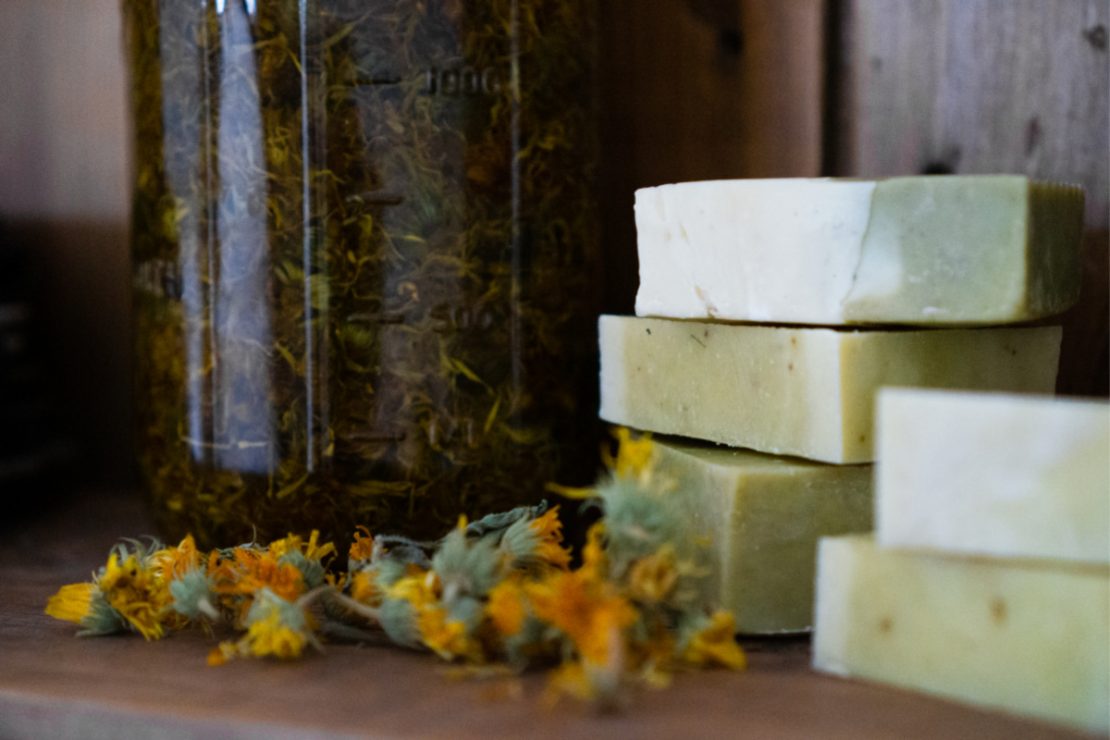
Herbal Soap Recipe for Eczema
If you’re living with eczema, bathing may cause more pain than pleasure. However, there is hope! Switching from commercial soaps to an herb-infused soap recipe for eczema may be all you need to start to feel some relief.
A few months back we walked through how to create herbal oils that could be used in any of your favorite homemade beauty DIYs. Now, let’s build on that knowledge. In this post, I will walk you through how to create our very own herbal soap—suitable for those with eczema and sensitive skin. A handful of ingredients are all that is needed to formulate a gentle, moisturizing soap for your sensitive skin.
My herbal soap-making journey began in 2013 because of my severe eczema, which has been a part of my life since childhood. Each month I endured painful flare-ups that caused my skin to get extremely dry, crack open, and bleed. Simple everyday tasks like driving, writing with a pen, or running my hands through my hair were excruciating because of the peeling skin. It was so terrible that I had to create a solution—natural skincare! By incorporating herbal soaps, butters, and salves into my personal care routine my hands began to heal. I’ve been dedicated to soapmaking and herbal education ever since.
Eczema is a form of dermatitis that often coincides with allergies, asthma, migraines, sinus problems, and gut issues. Inflammation and irritation are common themes(Groves, Maria Noel, 2016). Eczema causes red, itchy, and dry rashes that range from mild to severe(Higuera, 2019). The skin may get extremely dry and itch when agitated by irritants like laundry detergent, commercial soap, certain fabric blends, stress, diet, and climate conditions.
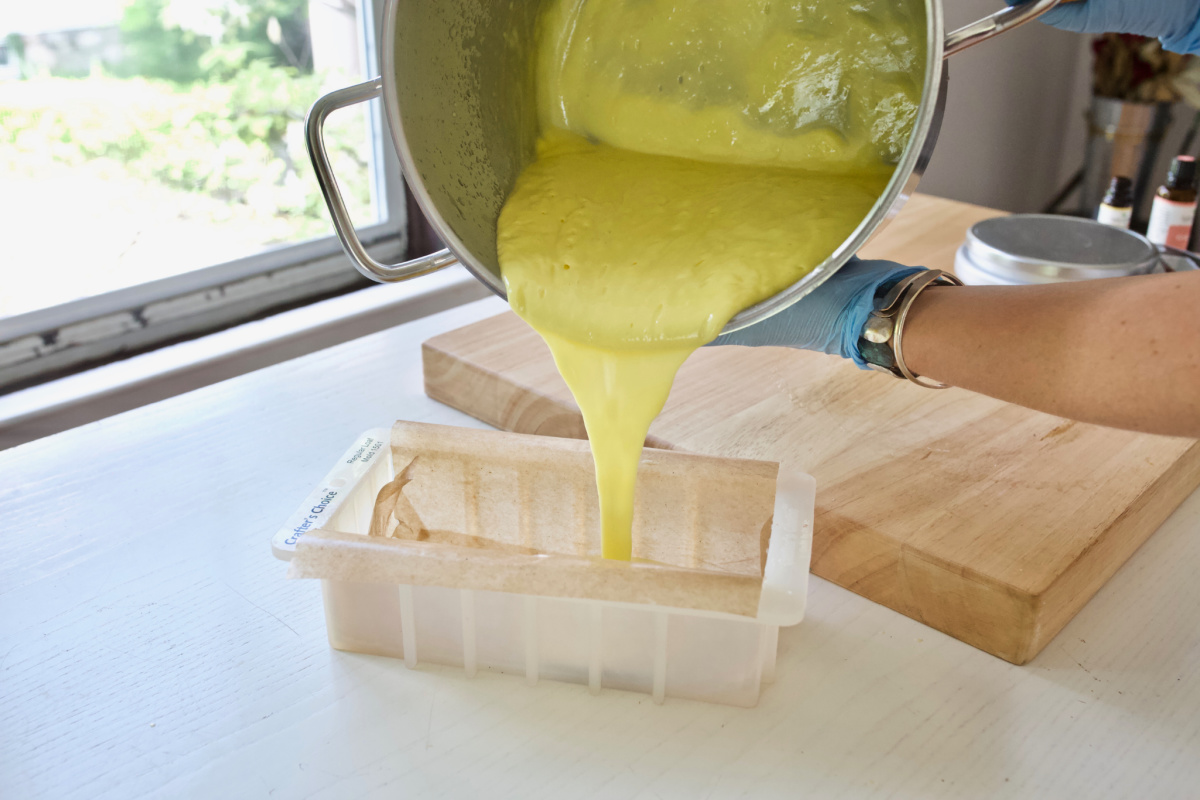
Hot Process Soapmaking
Soapmaking is done one of three ways: with melt and pour soap base, cold, or hot process. This recipe is done using the hot process method, which allows the soap to fully cook while in the crockpot, resulting in a shorter curing time. You can expect your soap to be ready to use about 48 -72 hours after you have set it in the mold to dry.
My first hot process soap recipe for eczema included the below ingredients. This soap bar offers a beautiful lather, tranquil fragrance, and skin-soothing ingredients. It is a great choice for everyday use and can be used all over the body. Though it is a gentle formula, you may want to test the soap on a small area of your face to ensure there is no negative reaction prior to use. To begin, you will want to collect all the below materials and set them up in a well-lit, ventilated area with a clean surface space.
Herbal Soap Materials
- 6 quart crockpot
- 2 glass 8-up batter bowls with spout
- Metal spoons
- Digital scale
- Soap mold
- Parchment paper
- Lye
Be sure to work with 100% pure lye when soaping. Dress in head-to-toe protective gear to avoid lye touching any part of your skin. This includes goggles, gloves, hair tie/net, long sleeves, and a face mask. Always be sure to add lye to water so it doesn’t splash up and burn you. Meaning, be sure to add the water first, then the lye. There is an easy saying to help you remember:“add water to lye and you may die!”. Sounds extreme, yes, so be sure not to mix it in that manner.
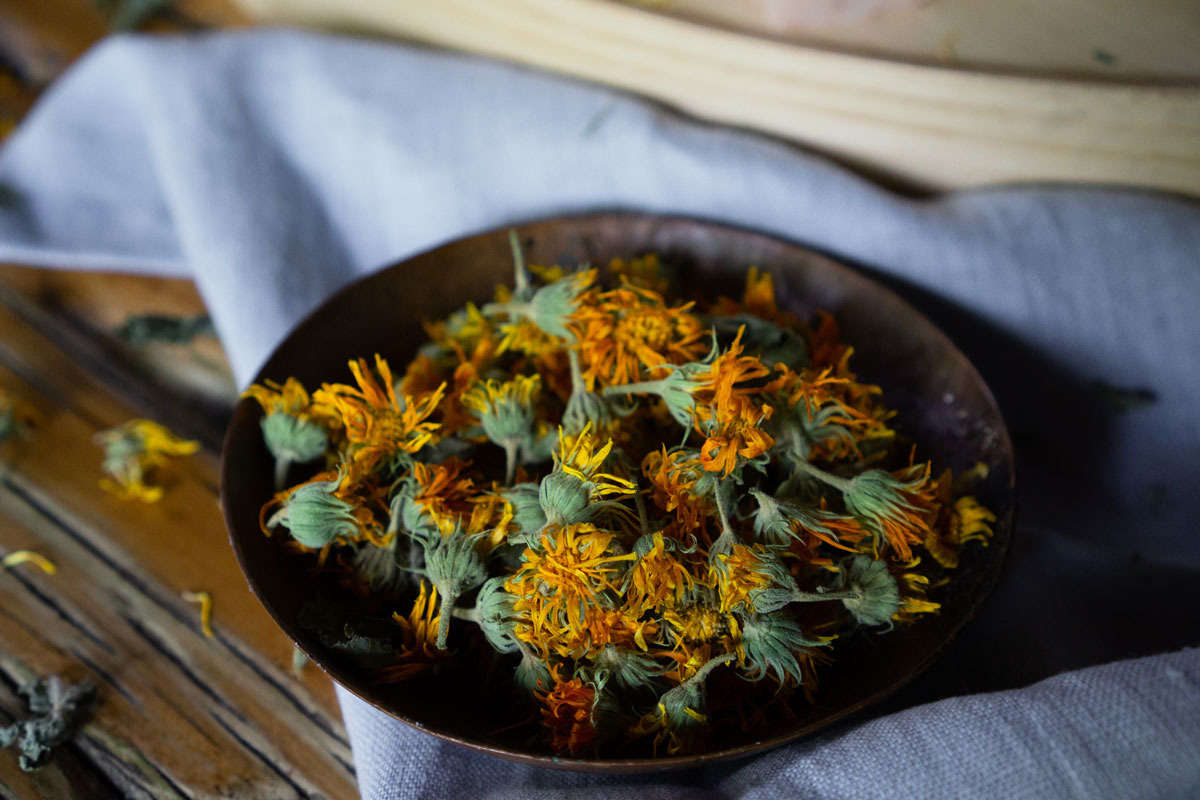
Eczema Friendly Ingredients
Bathing can be a nightmare for those dealing with an eczema flare-up. Symptoms include dry, red, itchy patches of skin that sting and begin to flake off. To combat this we want to use rich moisturizing ingredients as listed below. As you progress in your own soap-making journey, you may opt to use these or others. The general guideline is that you want to add carrier oils that have humectant qualities, are soothing to the skin, and have anti-inflammatory properties.
Calendula (Calendula officinalis) – The entire flower head is used to help promote the recovery from injury. When used externally, calendula is very useful in cases of eczema and other skin inflammations (Foley et al.,2013).
Olive oil is soothing for eczema-related inflammation and irritation. Rich in antioxidants, this oil adds hydration to the skin. The color can range from pale green to yellow depending on the level of filtration it went through.
Coconut oil is 100% fat, 80 -90% of which is saturated. This gives it a firm texture at cold or room temperatures. The oil is a wonderful moisturizer and cleanser. Adding it into the recipe will enhance the bubbles in the lather (Coconut Oil, 2020).
Mango butter’s texture is firmer than shea butter, but softer than cocoa butter. It is extracted from the fruit kernels of the mango tree and begins to melt upon contact with the skin. It’s a luxurious butter and adds a silky feel to the soap bar (Marie, 2019).
Castor oil is cleansing and skin conditioning. This thick oil adds a nice lather to the bar and hydration into the skin. Castor oil feels similar to glycerin with a thick and sticky texture. It also acts as a humectant on the skin, just like glycerin (Marie, 2016).
Manuka honey is anti-inflammatory and antibacterial which assists in wound and skin repair. The thick consistency is a humectant and draws moisture from the air into the skin. The main herbal use for manuka honey is to promote wound and burn healing. Research shows it to be effective in working with other conditions, including eczema and dermatitis (Saling, 2012).
Lavender essential oil – As both an essential oil and a crude herb, lavender can be applied to almost any skin issue: burns, irritations, rashes, etc. It soothes inflammation, fights germs, and supports healing (Groves, 2016).
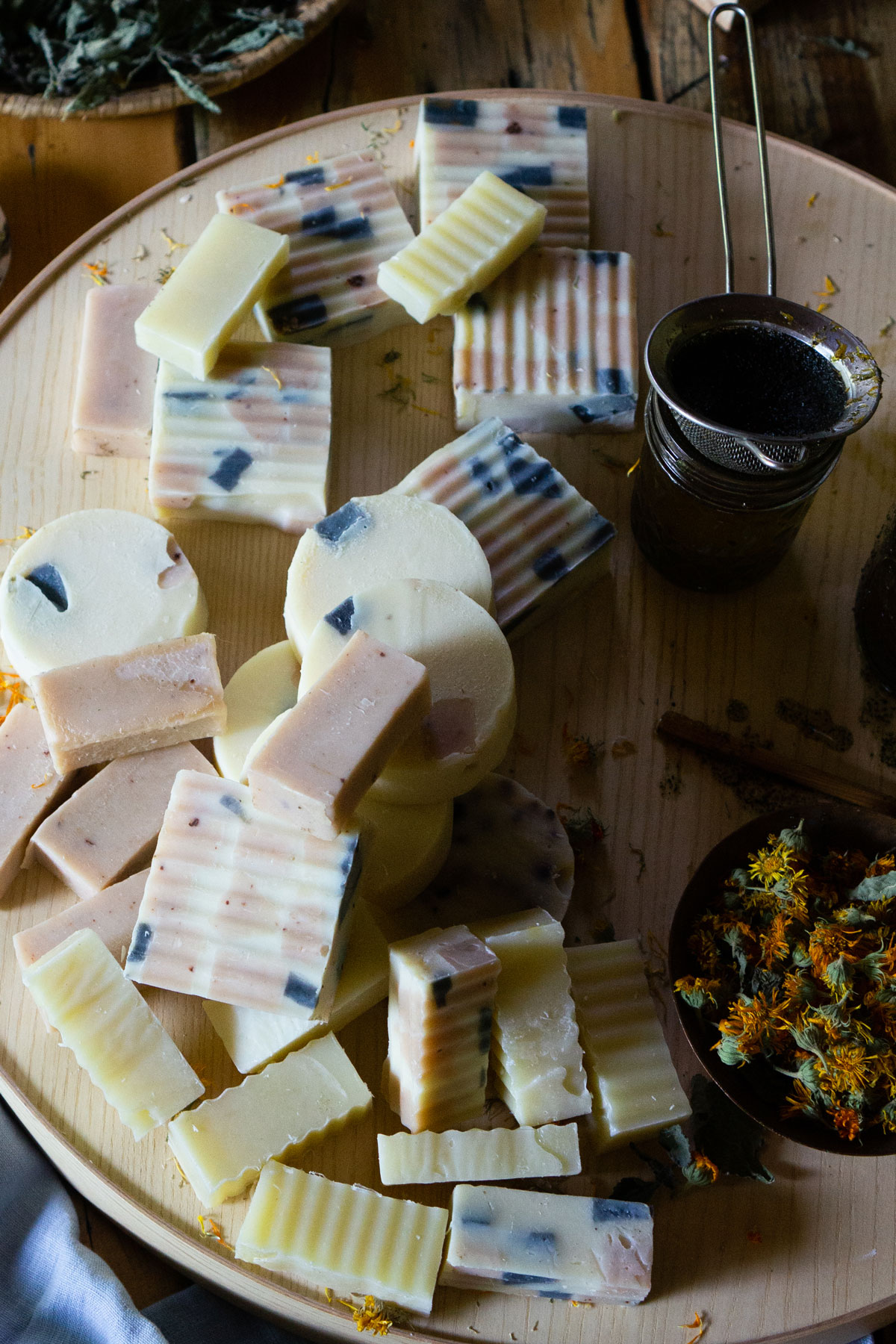
Herbal Eczema Soap Recipe
A simple, gentle starter soap formula for inflamed skin. Yield:2 pounds of soap.
12.6 fluid ounces distilled water
4.46 ounces lye
16 fluid ounces calendula-infused olive oil
8 ounces coconut oil
4.8 ounces mango butter
3.2 fluid ounces castor oil
1 tablespoon manuka honey
20-30 drops of lavender essential oil (optional)
4 tablespoons dried calendula petals (optional)
- Begin by putting on your safety gear, which should include goggles and gloves. Make sure to set up your workspace in a well-ventilated area.
- Prepare the mold by lining with parchment paper and setting it aside.
- Weigh out ingredients and then combine mango butter, coconut, olive, and castor oils in a glass bowl.
- Once all ingredients have been added, pour into the crockpot and turn to low heat. Cover with lid, cook until solid ingredients have become liquid.
- In separate two other bowls weigh out water and lye separately. Pour the lye slowly into the water while stirring. Important safety note: never add the lye first! Adding water to lye can cause the lye to splash. Stir until dissolved.
- Allow lye mixture to cool while oils in crockpot melt down into the liquid.
- Once the crockpot ingredients are melted add the lye water into the crockpot and mix with a stick blender until the consistency of pudding, also referred to as medium trace.
- Add the manuka honey to the crockpot and stir with a metal spoon before covering it with a crockpot top.
- Allow soap to cook, but keep a close eye to ensure it doesn’t bubble up and overflow from the crockpot.
- When the soap cooks down and into a wax-like consistency turn the heat off and allow to cool for 10 -15 minutes.
- Add 20-30 drops of lavender essential oil and stir (optional).
- Pour into lined mold and finish by topping with loose dried calendula petals (optional).
- Allow to dry in mold for 24-48 hours before unmolding and cutting into bar sizes of your choice.
In Closing,
Once your soap has hardened, unmold and enjoy for yourself or share with friends! Each completed batch allows you to test your herbal soap recipes and alter if necessary, the next time around. Crafting your own soaps is meditative and fun; the results can be appreciated first-hand or as gifts. If herbal skincare formulation is something you enjoy, check out Herbal Academy’s Natural Perfumery course to learn additional skills. Happy Soaping!
For more soapmaking posts, see:
Best Herbal Oils for Homemade Soaps
A DIY Floral Delight Soap Recipe You’ll Love!
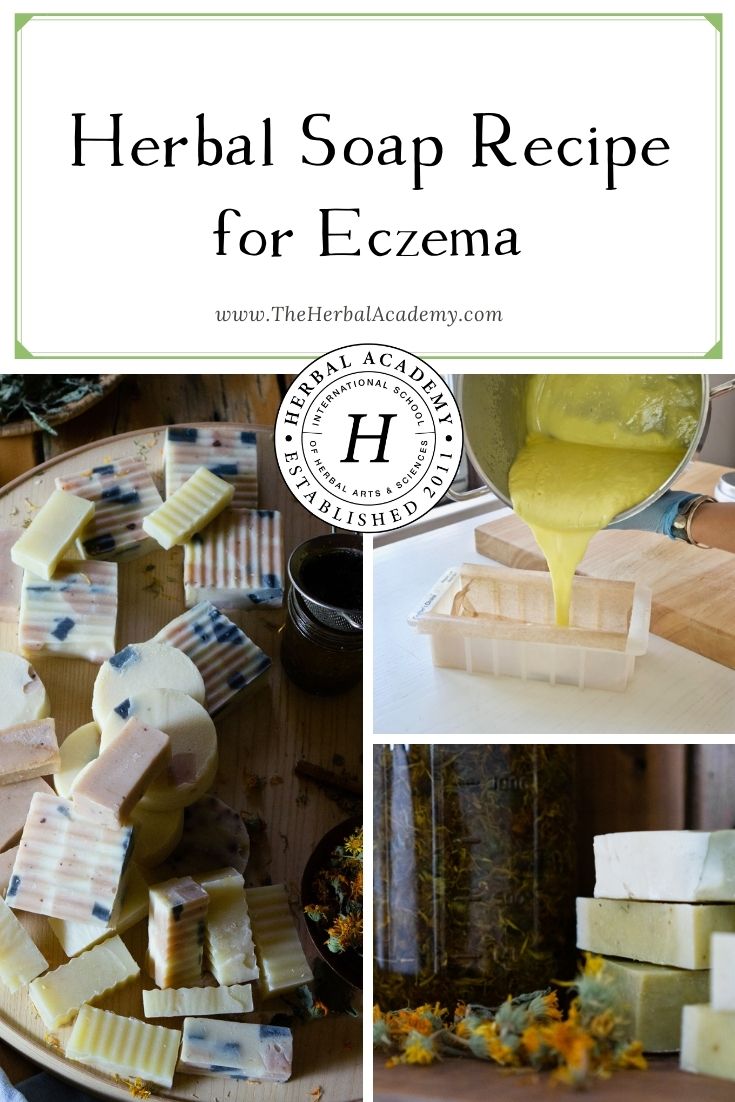
REFERENCES
Foley, C., Nice, J., & Webb, M. A. (2013). New herb bible. New York, NY: Adfo Books.
Groves, M. N. (2016). Body into balance: An herbal guide to holistic self-care. North Adams, MA:Storey Publishing, LLC.
Harvard School of Public Health. (n.d.). Coconut oil. Retrieved from https://www.hsph.harvard.edu/nutritionsource/foodfeatures/coconut-oil/#:%7E:text=Coconut%20oil%20is%20made%20by,not%20regulated%20with%20coconut%20oil
Higuera, V. (2019). Essential oils for severe eczema. Healthline [Website]. Retrieved from https://www.healthline.com/health/severe-eczema/essential-oils
Marie, A. (2019). All about butters in bath & beauty products. Soap Queen [Blog]. Retrieved from http://www.soapqueen.com/bath-and-body-tutorials/tips-and-tricks/all-about-butters-in-bath-beauty-products
Marie, A. (2016). Sunday night spotlight: Castor oil. Soap Queen [Blog]. Retrieved from https://www.soapqueen.com/bath-and-body-tutorials/tips-and-tricks/sunday-night-spotlight-castor-oil
Saling, J. (2012). Manuka honey. WebMD [Website]. Retrieved from https://www.webmd.com/a-to-z-guides/manuka-honey-medicinal-uses#:%7E:text=Manuka%20honey%20is%20made%20in,known%20as%20a%20tea%20tree)








